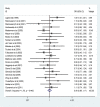Correlation between CTLA-4 gene rs221775A>G single nucleotide polymorphism and multiple sclerosis susceptibility. A meta-analysis
- PMID: 28352806
- PMCID: PMC5329839
- DOI: 10.1515/med-2016-0052
Correlation between CTLA-4 gene rs221775A>G single nucleotide polymorphism and multiple sclerosis susceptibility. A meta-analysis
Abstract
Objective: The aim of this meta-analysis was to undertake a meta-analysis to evaluate the correlation between cytotoxic T-lymphocyte-associated protein 4 (CTLA-4) gene rs221775 A>G single nucleotide polymorphism and the susceptibility of multiple sclerosis (MS) susceptibility.
Method: Published manuscripts about CTLA-4 gene rs221775A>G single nucleotide polymorphism and multiple sclerosis susceptibility were searched in the computerized bibliographic searches of Pubmed Embase and China National Knowledge Infrastructure (CNKI). Potential studies were screened and data for 5025 MS patients and 4706 controls from 20 publications were included. The association between CTLA-4 gene rs221775A>G single nucleotide polymorphism and multiple sclerosis susceptibility were demonstrated by odds ratio (OR) and 95% confidence interval (95%CI).
Results: The pooled results showed no significant association between CTLA-4 gene rs221775A>G single nucleotide polymorphism and multiple sclerosis susceptibility for dominant genetic model [OR=1.02, 95%CI:0.90~1.05, (P=0.80)], homozygous genetic model [OR=0.85,95%CI:0.71 ~1.03,(P=0.10)] and recessive genetic model [OR=0.99,95% CI:0.89~1.10,(P=0.90)].
Conclusion: With current evidence, CTLA-4 gene rs221775A>G single nucleotide polymorphism had no association with the susceptibility of multiple sclerosis.
Keywords: CTLA-4 gene; Meta-analysis; Multiple sclerosis; Polymorphism; Susceptibility.
Figures






Similar articles
-
Lack of association between cytotoxic T-lymphocyte antigen-4+49A/G polymorphism and psoriasis and vitiligo: A meta-analysis of case-control studies.Gene. 2015 Sep 1;568(2):196-202. doi: 10.1016/j.gene.2015.05.051. Epub 2015 May 24. Gene. 2015. PMID: 26013045
-
CTLA-4 +49 A/G and -318 C/T polymorphisms and susceptibility to multiple sclerosis: a meta-analysis.Immunol Invest. 2013;42(5):409-22. doi: 10.3109/08820139.2013.803114. Immunol Invest. 2013. PMID: 23802171
-
CTLA-4 and MDR1 polymorphisms increase the risk for ulcerative colitis: A meta-analysis.World J Gastroenterol. 2015 Sep 14;21(34):10025-40. doi: 10.3748/wjg.v21.i34.10025. World J Gastroenterol. 2015. PMID: 26379408 Free PMC article. Review.
-
Association of Cytotoxic T-lymphocyte Antigen-4 Polymorphisms with Malignant Bone Tumor Risk: A Meta-analysis.Asian Pac J Cancer Prev. 2016;17(8):3785-91. Asian Pac J Cancer Prev. 2016. PMID: 27644617
-
Lack of association between CTLA-4 +49A/G and -318C/T polymorphisms and Behçet's disease risk: a meta-analysis.Clin Exp Rheumatol. 2012 May-Jun;30(3 Suppl 72):S46-50. Epub 2012 Sep 25. Clin Exp Rheumatol. 2012. PMID: 23010350 Review.
Cited by
-
Current understanding of CTLA-4: from mechanism to autoimmune diseases.Front Immunol. 2023 Jul 11;14:1198365. doi: 10.3389/fimmu.2023.1198365. eCollection 2023. Front Immunol. 2023. PMID: 37497212 Free PMC article. Review.
-
Advances in immune checkpoint-based immunotherapies for multiple sclerosis: rationale and practice.Cell Commun Signal. 2023 Nov 9;21(1):321. doi: 10.1186/s12964-023-01289-9. Cell Commun Signal. 2023. PMID: 37946301 Free PMC article. Review.
-
Investigating the functional and structural effect of non-synonymous single nucleotide polymorphisms in the cytotoxic T-lymphocyte antigen-4 gene: An in-silico study.PLoS One. 2025 Jan 24;20(1):e0316465. doi: 10.1371/journal.pone.0316465. eCollection 2025. PLoS One. 2025. PMID: 39854591 Free PMC article.
-
The Role of Cytotoxic T-Lymphocyte Antigen 4 in the Pathogenesis of Multiple Sclerosis.Genes (Basel). 2022 Jul 24;13(8):1319. doi: 10.3390/genes13081319. Genes (Basel). 2022. PMID: 35893056 Free PMC article. Review.
References
-
- Yousefipour G, Erfani N, Momtahan M, Moghaddasi H, Ghaderi A. CTLA4 exon 1 and promoter polymorphisms in patients with multiple sclerosis. Acta Neurol Scand. 2009;120(6):424–429. - PubMed
-
- Kampman MT, Eriksen EF, Holmoy T. Multiple sclerosis, a cause of secondary osteoporosis? What is the evidence and what are the clinical implications. Acta Neurol Scand Suppl. 2011;191:44–49. - PubMed
-
- MacLean HJ, Freedman MS. Multiple sclerosis: following clues from cause to cure. The Lancet Neurology. 2009;8(1):6–8. - PubMed
-
- Ligers A, Xu C, Saarinen S, Hillert J, Olerup O. The CTLA-4 gene is associated with multiple sclerosis. J Neuroimmunol. 1999;97(1-2):182–190. - PubMed
-
- Maurer M, Ponath A, Kruse N, Rieckmann P. CTLA4 exon 1 dimorphism is associated with primary progressive multiple sclerosis. J Neuroimmunol. 2002;131(1-2):213–215. - PubMed
LinkOut - more resources
Full Text Sources
Other Literature Sources
